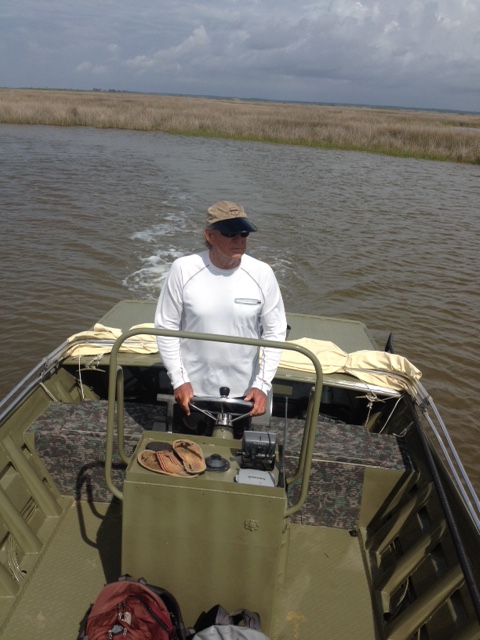
by Rick O'Connor | Dec 17, 2021
Recently I watched a documentary on TV entitled The Loneliest Whale; the search for 52. The title grabbed my attention and so, I checked it out.
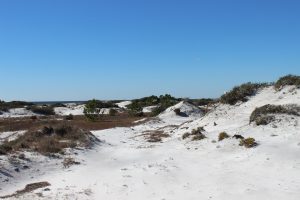
There are many forms of wildlife that are very hard to find in our area. But we continue to look.
Photo: Rick O’Connor
Seems a decade or so ago the U.S. Navy was doing SONAR work in the Pacific between Washington and Alaska and detected a strange sound coming in at 52 hertz. They had not herd this before and would continue to hear it in different locations around the northern Pacific. Their first concern was it was something new from the Russians, but when they showed the graphs and played the recording to a marine mammologist named Dr. Watkins, they found that it was most likely a “biological” – mostly likely a whale.
The problem was that Dr. Watkins had never heard whales calling at 52 hertz. If it was a whale, it was calling a lot – but no other whales were answering. Hence the name “the loneliest whale”. If it was a whale, and no others would talk to it, it was kind of sad. But who was this whale? What kind was it?
Word of the loneliest whale spread around the world and many humans made a connection to this animal, possibly because of their own disconnect with their own species. Stories and ballads were written, and people began to feel for the poor animal that apparently had no friends.
This story caught the attention of a documentary film maker who was interested in finding “52”, as the whale became known. He solicited the help of other marine mammologists; Dr. Watkins had died. According to those marine mammologists, this was going to be VERY difficult. It is hard enough to find just a pod of whales in the open Pacific, much less a specific pod with a specific individual. But they were excited about the challenge of finding this one animal, “52”, and off they went.
As I was watching this documentary it reminded me of my own search here near Pensacola. In 2005, I was asked by members of state turtle groups if I could search to see if diamondback terrapins lived in the western panhandle. This turtle’s range is from Cape Cod Massachusetts to Brownsville Texas, but there were no records from the Florida panhandle. Did the animal exist there? I was running the marine science program at Washington High School at the time and thought this would be a good project for us. So, we began.
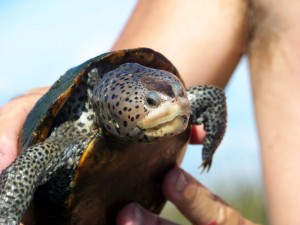
Mississippi Diamondback Terrapin (photo: Molly O’Connor)
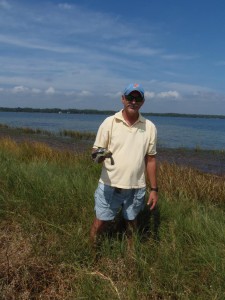
This small turtle can be held safely by grabbing it near the bridge area on each side.
Photo: Molly O’Connor
The students researched terrapin biology and ecology to determine the locations with the highest probability of finding, and we searched. I quickly found that the best time to search for terrapins was during nesting in May and June, and that the worst time to do a project with high school seniors was May and June. So, the project fell on my wife and me. For two years we searched all the “good spots” and found nothing. We placed “Wanted Poster’s” at boat ramps near the good spots with only calls about other species of turtles, not the terrapin.
Then one day in a call came in from a construction worker. Said he had seen the turtle we were looking for. For over a year we had been chasing “false calls” of terrapins. So, I was not overly excited thinking this would be another box turtle or slider. I asked a few questions about what he was looking at and he responded with “you’re the guy who put the wanted poster up correct? – well your turtle is standing next to the poster… it’s the same turtle”. Now I was excited. We did some surveys in that area and in 2007 saw our first terrapin! I can’t tell you how exciting it was. Two years of searching… at times thinking we might work on another project with a different species that actually exists… reading that the diamondback terrapin is like the Loch Ness monster – everyone talks about them, but no one has ever seen one. And there it was, a track in the sand and a head in the water. Yes Virginia… terrapins do exist in the Florida panhandle. The excitement of finding one was indescribable.
We were hooked. We now had to look in other counties in the panhandle, and yes, we found them. As I watched the program of the marine mammologists searching for “52” I could completely relate.
Today, as a marine educator with Florida Sea Grant, I train others how to do terrapin surveys and searches. I let them know how hard it is to find them and to not get disappointed. When they do see one, it will be a very exciting and fulfilling day. Our citizen science program has expanded to searching for other elusive creatures in our bay area. Bay scallops, which are all but gone however we do find evidence of their existence and spend time each year searching for them. In the five years we have been searching we have found only one live scallop, but we are sure they are there. We find their cleaned shells on public boat ramps – by the way, it is illegal to harvest bay scallops in the Pensacola Bay area. Another we are searching for is the nesting beaches of the horseshoe crabs. This is another animal that basically disappeared from our waters but are occasionally seen now. It is exciting to find one, but we are still after their nesting beaches and the chase is on.
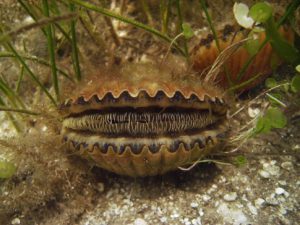
Bay Scallop Argopecten irradians
http://myfwc.com/fishing/saltwater/recreational/bay-scallops/

Horseshoe crabs breeding on the beach.
Photo: Florida Sea Grant
I love the challenge of searching for such creatures. If you do as well, we have a citizen science program that does so. You can just contact me at the Escambia County Extension Office to get on the training list, trainings occur in March, and we will get you out there searching. As for whether they found “52”, you will have to watch the program 😊
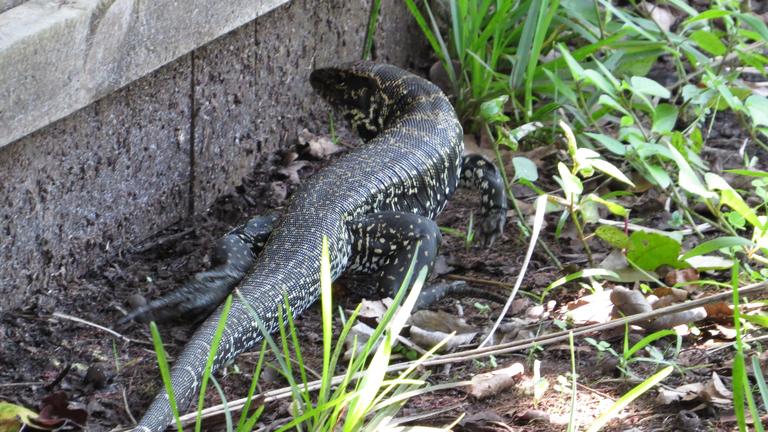
by Rick O'Connor | Dec 17, 2021
EDRR Invasive Species
Black and White Argentine Tegu
(Salvator merianae)

The Argentine Black and White Tegu.
Photo: EDDMapS.org
Define Invasive Species: must have all of the following –
- Is non-native to the area, in our case northwest Florida
- Introduced by humans, whether intentional or accidental
- Causing either an environmental or economic problem, possibly both
Define EDRR Species: Early Detection Rapid Response. These are species that are either –
- Not currently in the area, in our case the Six Rivers CISMA, but a potential threat
- In the area but in small numbers and could be eradicated
Native Range:
The Argentine Black and White Tegu is native to South America.
Introduction:
The tegu was introduced to Florida through the pet trade. Some animals either escaped or were released.
EDDMapS currently list 7,014 records of the Argentine Black and White Tegu in the U.S. 5,908 (84%) are from Miami-Dade County. There are 12 records from Georgia and one from Memphis Tennessee. The majority of records are from south Florida.
There are 12 records from the Florida panhandle and five within the Six Rivers CISMA. The only confirmed breeding pairs are in Miami-Dade, Hillsborough, and Charlotte counties in Florida.
Description:
Tegus are long black and white banded lizards that can reach four feet in length. They prefer high dry sandy habitats but can be found in a variety of habitats including agricultural fields.
Issues and Impacts:
Basically… they eat everything. Being omnivores, stomach analysis indicates they will feed on fruits, vegetables, eggs, insects, and small animals. These animals include lizards, turtles, snakes, lizards, and small mammals. They feed primarily on ground dwelling creatures. A typical tegu clutch will have 35 eggs.
The consumption of fruits and vegetables can have a major impact on agricultural row crops throughout Florida. Their habit of consuming eggs would include the American alligator, the American crocodile, and the gopher tortoise – all protected species.
Records show the number of tegus trapped each year is growing, with over 1400 captured in 2019. This suggests the populations are increasing and new breeding colonies are probable. There are also records of the animal in north Florida and Georgia, suggesting they can tolerate the colder winters of those regions.
Management:
Management is currently with trapping. Both the Florida Fish and Wildlife Conservation Commission and their subcontracted trappers are currently the primary method of removing the animals. Researchers from the University of Florida as well as those mentioned above frequently conduct roadside surveys searching for these animals. We ask anyone who has seen a tegu to report it on the IveGotOne App found on the EDDMapS website – www.eddmaps.org – or the website itself, and call your local extension office.
For more information on this EDRR species, contact your local extension office.
References
Control of Invasive Tegus in Florida. The Croc Docs. https://crocdoc.ifas.ufl.edu/projects/Argentineblackandwhitetegus/
Harvey, R.G., Dalaba, J.R., Ketterlin, J., Roybal, A., Quinn, D., Mazzotti, F.J. 2021. Growth and Spread of the Argentine Black and White Tegu Population in Florida. University of Florida IFAS Electronic Data Information System. https://edis.ifas.ufl.edu/publication/UW482
Harvey, R.G., Mazzotti, F.J. 2015. The Argentine Black and White Tegu in South Florida; Population, Spread, and Containment. University of Florida IFAS Publication WEC360.
https://crocdoc.ifas.ufl.edu/publications/factsheets/tegufactsheet.pdf
Johnson, S.A., McGarrity, M. 2020. Florida Invader: Tegu Lizard. University of Florida Wildlife Ecology Conservation. WEC295. https://edis.ifas.ufl.edu/pdf/UW/UW34000.pdf
Early Detection and Distribution Mapping System (EDDMapS)
https://www.eddmaps.org/
Six Rivers CISMA
https://www.floridainvasives.org/sixrivers/
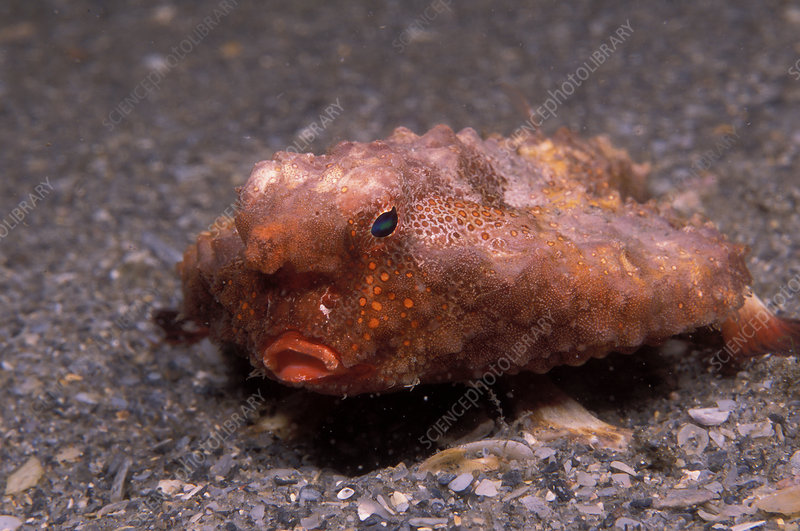
by Rick O'Connor | Dec 17, 2021
This is another one of those fish in this series that is not often seen but when you do see one you will ask “what is that?” – So, we will answer the question by including it here.
Like the frogfish we have already written about, batfish are described by Hoese and Moore1 as “grotesque” and they take it a step further by telling us all “ugly” fish (as they say) are grouped into what many call “dogfish”. As with the frogfish, I am not sure I would use the term grotesque, but they are strange looking.
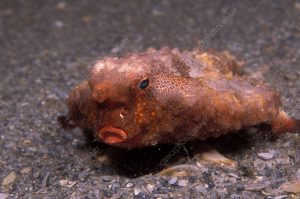
Juvenile Polka-Dot Batfish (Ogcocephalus radiatus) in the polluted intracoastal waterway in Palm Beach County, FL.
Photo: Science Photo Library
I have only seen a couple in my life. Hoese and Moore mention they are often brought up in shrimp trawls, and I have seen them while doing trawl surveys at Dauphin Island Sea Lab. I also found one while snorkeling along a seawall near Gulf Breeze FL. So, they are out there just not encountered as often, or as well known, or seen as frequently, as many other fish in the Gulf. Another reason to include this group here.
It is hard to describe what this fish looks like. They are, as they say, dorso-ventrally flattened – meaning from top to bottom, not side to side – like a stingray. They have two fins extending from parts of their body that sort of “stick out of the side” and appear to be like webbed feet with which they walk. Actually, there are these small, modified fins on the ventral side that are used to walk on the bottom – they are bottom dwelling (benthic) fish for sure. Like their relatives the frogfish they have a modified spine that is used like a fishing lure. Like the frogfish, the shape of that lure can be used to identify species. But unlike the frogfish the lure is located between their mouth (which near the bottom of the body and is very small) and a pointed rostrum that extends from the top of their head like a battering ram. This lure is extended to lure not fish swimming above, as with the frogfish, but small creatures in and on the sand. Because of this they do not call the lure an illicium but a esca. These are strange looking fish.
Hoese and Moore list four different species and indicate there are at least three others in the Gulf of Mexico. Most are associated with the continental shelf of the Gulf and not inland where we might see them snorkeling around. A couple of species are more associated the continental slope, which drops from the continental shelf to the deep sea. But the Polka-dot batfish (Ogocephalus cubifrons) is reported as being inshore and is the species I have encountered.
Many species are only described as being from the shelf of the Gulf of Mexico and no other oceans. Some of them are even more restricted to either the eastern or western Gulf. This all suggests that batfish do have biogeographic barriers of some sort restricting their dispersal. Being offshore benthic fish, your first guess would be substrate. Usually in those locations the temperature and salinities are pretty similar but the material on the bottom (rock, shell, sand, canyons, etc.) are not. However, several articles mention that batfish can be found over rocky or sandy bottom2,3,4 and the polka-dot batfish can be found in grassbeds as well2. So, I am not sure what the possible barrier is, but several do have a limited range. The east-west split could very well be the DeSoto Canyon off the coast of Pensacola.
All of that said, it is a very interesting group of fish that for one species you might encounter while out and about snorkeling or diving in the Florida panhandle.
References
1 Hoese, H.D., Moore, R.H. 1977. Fishes of the Gulf of Mexico; Texas, Louisiana, and Adjacent Waters. Texas A&M Press. College Station, TX. Pp. 327.
2 Ogocephalus cubifrons, Polka-dot batfish. 2017. Discover Fishes. Florida Museum of Natural History. https://www.floridamuseum.ufl.edu/discover-fish/species-profiles/ogcocephalus-cubifrons/.
3 The Red-lipped Batfish. 2014. Ashland Vertebrate Biology. Ashland University, Ohio. http://ashlandvertbio.blogspot.com/2014/12/the-red-lipped-batfish.html.
4 Cocos Batfish, Ogocephalus porrectus. 2015. Smithsonian Tropical Research Institute. https://biogeodb.stri.si.edu/sftep/en/thefishes/species/777.
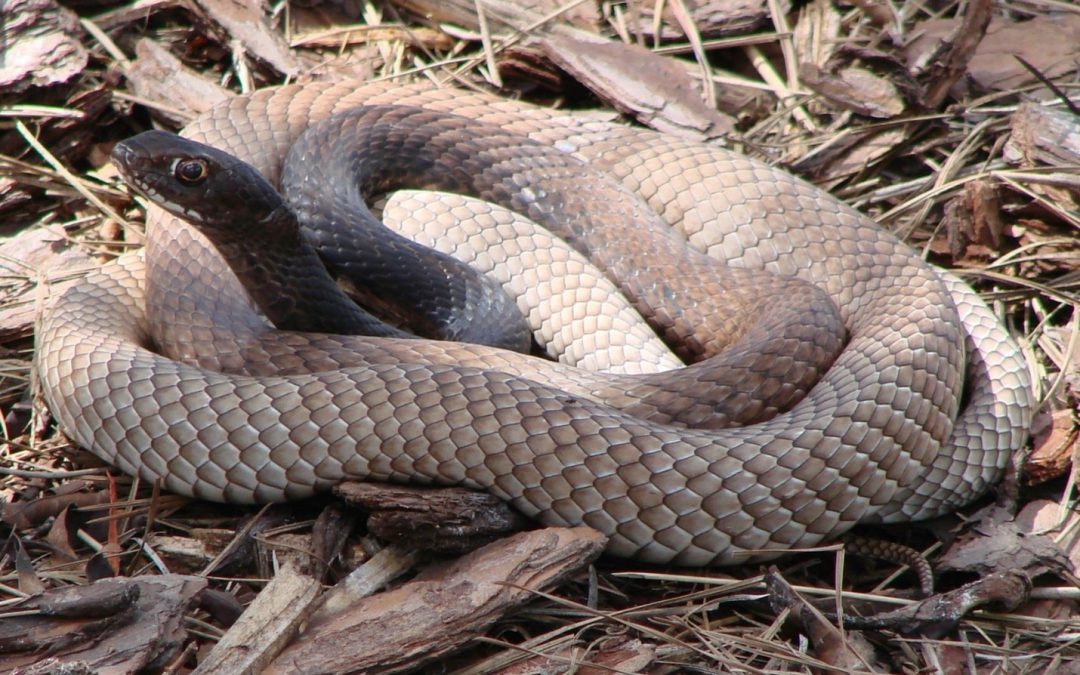
by Rick O'Connor | Dec 10, 2021
By Dr. Steve A. Johnson, Department of Wildlife Ecology & Conservation, University of Florida
As I was pondered writing about snakes for Panhandle Outdoors, an email notification appeared on my computer screen: “Snake in Pensacola Bay”. As a State Extension Specialist with the University of Florida’s Institute of Food and Agricultural Sciences I receive a lot of email requests to identify snakes and other reptiles. But the subject line of this message really got my attention because most of Florida’s approximately 50 species of native snakes are terrestrial, and with few exceptions, our aquatic snakes only occur in freshwater. Florida is home to one snake that lives in the marine environment, the Saltmarsh Watersnake (Nerodia clarkii), but they inhabit shorelines and rarely stray far from cover. And sea snakes are only found the Pacific Ocean basin—they do not naturally occur in the Gulf of Mexico.
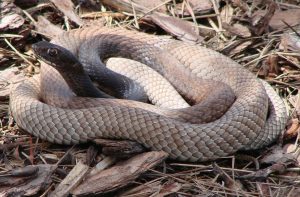
Eastern Coachwhips are long and thin, and most adults have a dark head and upper body. The rest of the body is tan or brown and the scale pattern on the tail resembles a braided bullwhip. Photo by Nancy West.
With anticipation I opened the email and viewed the attached images. To my surprise the snake seen by a fisherman who “came across a snake swimming out in the middle” of Pensacola Bay was an Eastern Coachwhip (Masticophis flagellum). In my almost 20 years with the University of Florida I’ve been emailed hundreds of times with requests to identify snakes. Although the coachwhip is a fairly common snake in Florida, its rarely the species I’m asked to identify. But I distinctly remember another email about 10 years ago from a gentleman in southeastern Florida who claimed he had killed a deadly Taipan snake, or at least something that looked to him like a Taipan. He told me he had lived in Florida for 30 years and knew how to identify snakes, but he had never seen a native snake that looked like this. There are three recognized species of Taipans, they are all native to Australia and are among the world’s most venomous land snakes. However, Florida is the global epicenter for introductions of non-native reptiles, due mainly to imports for the exotic pet reptile trade, so I did not immediately dismiss his assertion of Taipan, but I was highly suspect. Fortunately, the image attached to the email was not a Taipan. But unfortunately, it was an Eastern Coachwhip that he needlessly killed. Coachwhips are not venomous and are certainly not deadly of even dangerous, unless you are a lizard.
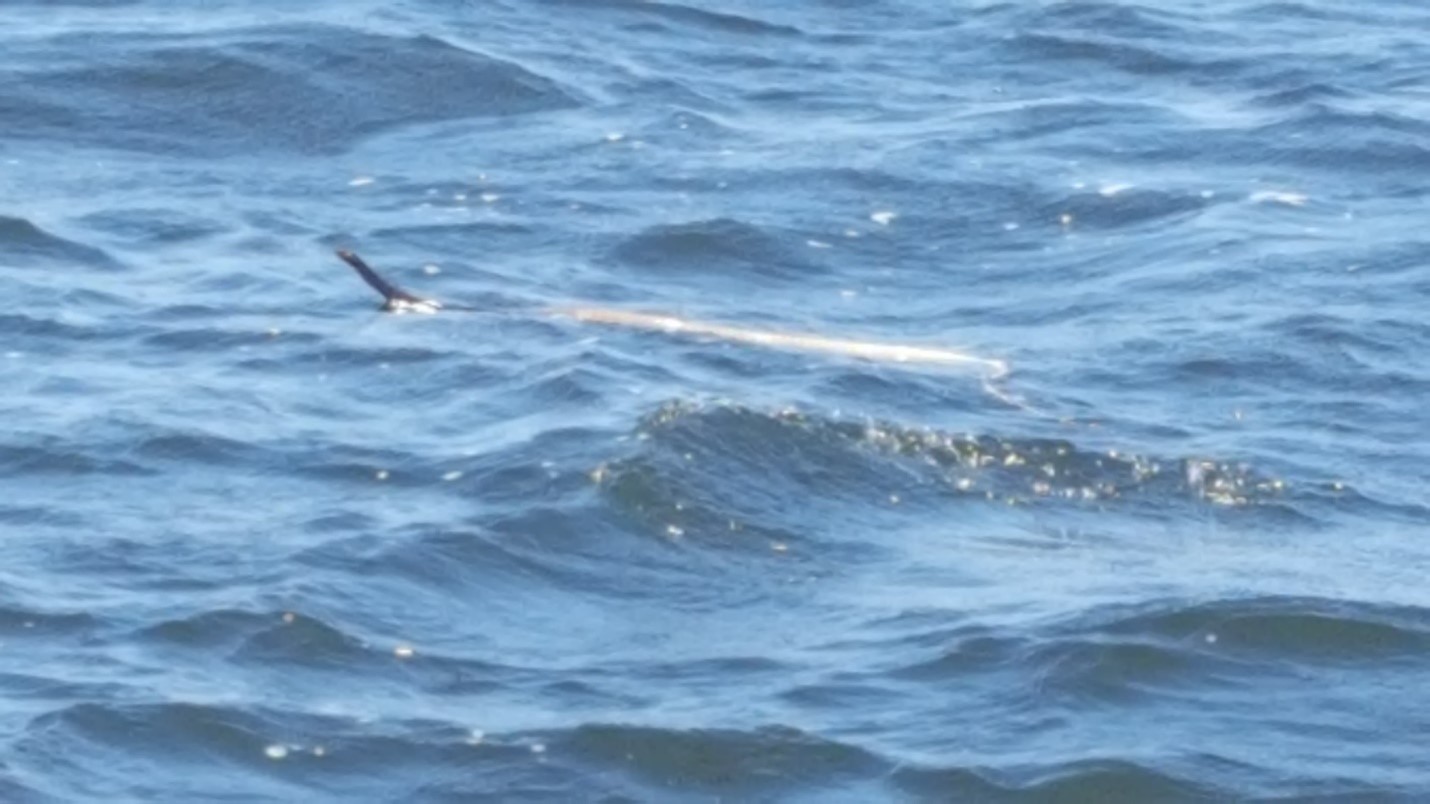
The dark head and upper body followed by a tan color allowed positive identification of this snake in Pensacola Bay as an Eastern Coachwhip. Photo by David Celko.
Coachwhip snakes are closely related to the Black Racer, the common “black snake” of the Southeast. Like racers, coachwhips are long, thin snakes with relatively large eyes. In fact, the Eastern Coachwhip is one of the longest native snakes in North America, reaching a maximum length of 8.5 feet, including the tail. The head and upper body of adult Eastern Coachwhips are usually dark brown or black, fading to brown or tan the rest of the length of their thin body. The scales on their tail resemble the braided pattern of a bullwhip, which is where they get their common name of coachwhip. Young Eastern Coachwhips are also tan colored, but they lack the dark head and upper body. The large eyes are especially obvious in young coachwhips.
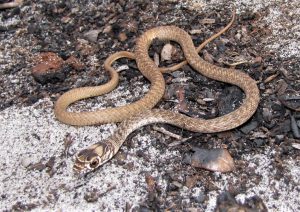
Juvenile Eastern Coachwhips are quite thin and have large eyes. They lack the dark-colored head and upper body of most adults. Photo by Dr. Steve A. Johnson, UF/IFAS.
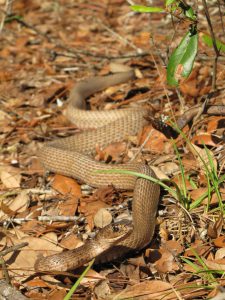
In northern peninsular Florida adult Eastern Coachwhips may lack a dark-colored head and upper body. Photo by Dr. Steve A. Johnson, UF/IFAS.
Eastern Coachwhips actively forage for lizards during the day, and they also eat small mammals, birds, frogs, and even small turtles. While hunting for prey they often move about with their head raised above the ground, visually searching for signs of movement. Eastern Coachwhips have a strong bite, which is how they subdue larger prey—they do no kill prey by constriction like do rat snakes. Coachwhips are fast snakes and can crawl more than 3.5 mph. When startled they often rapidly escape into a burrow or climb into a shrub or small tree. At night they shelter in burrows made mammals as well as the Gopher Tortoise.
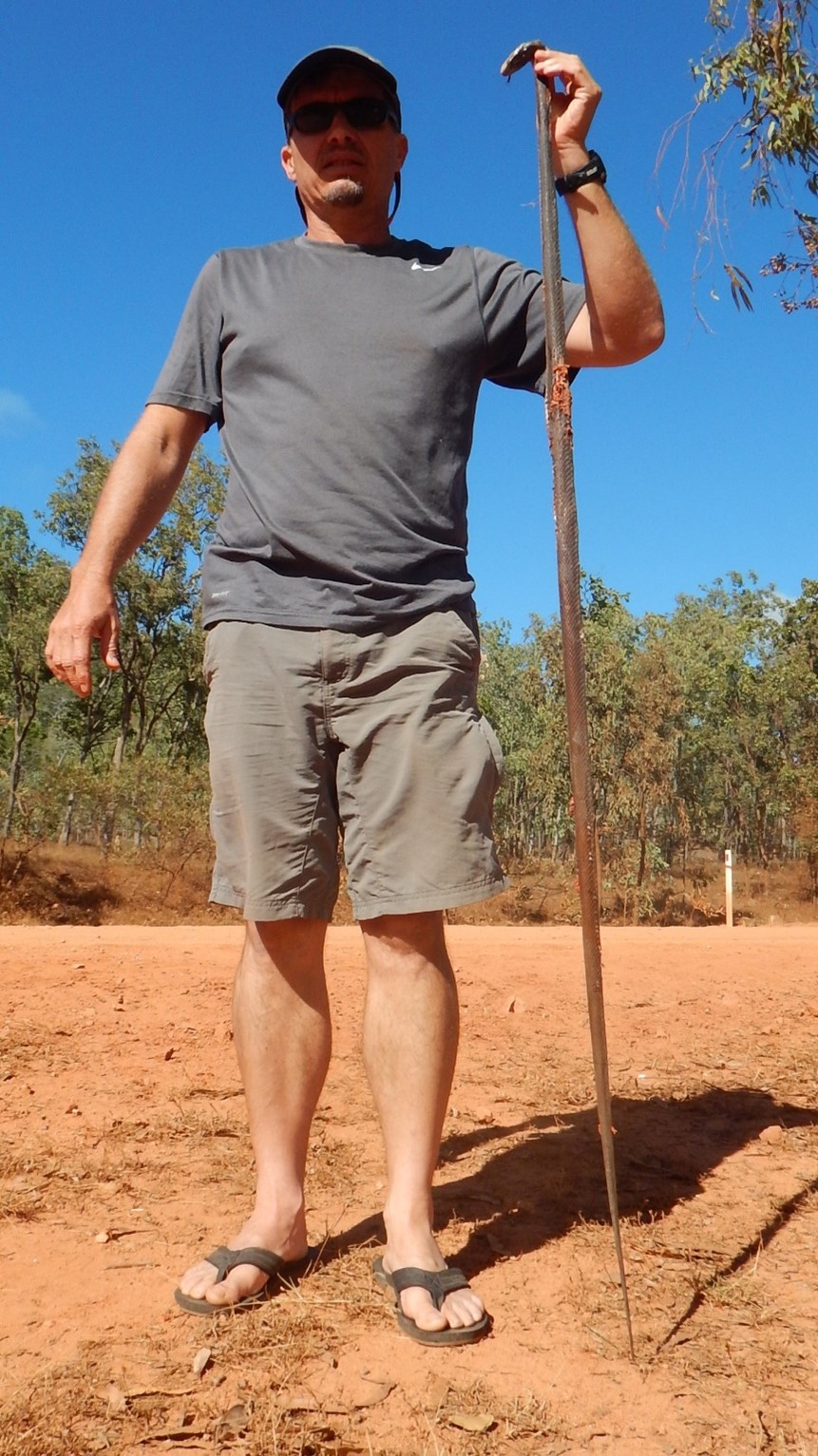
The author holding a (dead) highly venomous Taipan in far north Queensland, Australia. Even in very remote places, roads and vehicles are a source of snake mortality. The Taipan resembles the Eastern Coachwhip of Florida, but taipans only occur in Australia. Photo by Dr. Todd Campbell, University of Tampa.
Like all Florida’s snakes, Eastern Coachwhips are threatened by habitat loss and fragmentation by roads. Coachwhips move around a lot, and often get smashed by vehicles. So do the right thing and “give a snake a brake” the next time you see one attempting to cross a road. And certainly, never kill an Eastern Coachwhip on purpose as they are not venomous and don’t pose any danger to people or pets.
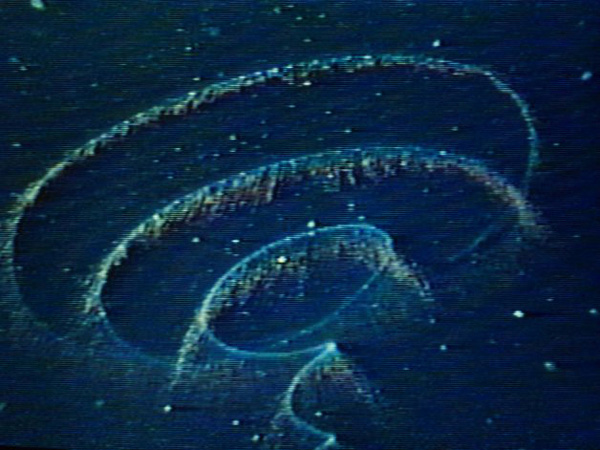
by Rick O'Connor | Dec 10, 2021
Most people would agree that this is one of the best times of the year. Christmas brings great music, great cooking, great family gatherings, and… great lights. The lighting of Christmas is one of the more beautiful parts of these celebrations and as I thought about Christmas and writing about nature I thought of those lights.

There is nothing like Christmas lights on a tree.
Photo: Molly O’Connor
Nature can produce beautiful lights as well. Mostly found in the ocean – “phosphorus”, as many called it when I was growing up here, is a beautiful spectacle. It is hard to see with our artificial lights but in the warmer months of summer at locations far from the artificial lights of people, the sea glows a blue-green color that is amazing. Many see this light as sparkles in the water as the waves roll by. Others see it as a stream of light as a fish, or something else, moves around. In the right conditions, you can see your footprints glow as you step in the wet sand. I remember diving at night under the Bob Sikes Bridge once in the 1970s when the bridge, and all of the divers, were aglow. It was beautiful. This phenomena have amazed scientists for centuries and trying to understand how it is produced was a quest for many.
The term phosphorescence actually means using light to emit light. Turns out that is not what is happening in this case. Scientists found that some creatures posses a group of molecules known as luciferins. The term lucifer means “producing light” or “morning star” and seemed an appropriate name for this group of molecules. When luciferin is oxidized, the transfer of an electron emits a “cool light” – usually blue-green in color. Cool meaning that less than 20% of the emitted light is lost as heat. There is a catalytic enzyme known as luciferase that can increase the speed of this chemical reaction and produce bright light in seconds. Since this light is produced by a chemical reaction it was called “chemiluminescence”. However, since this reaction is produced and controlled by living organisms is more widely known as “bioluminescence”. It is not phosphorescence.
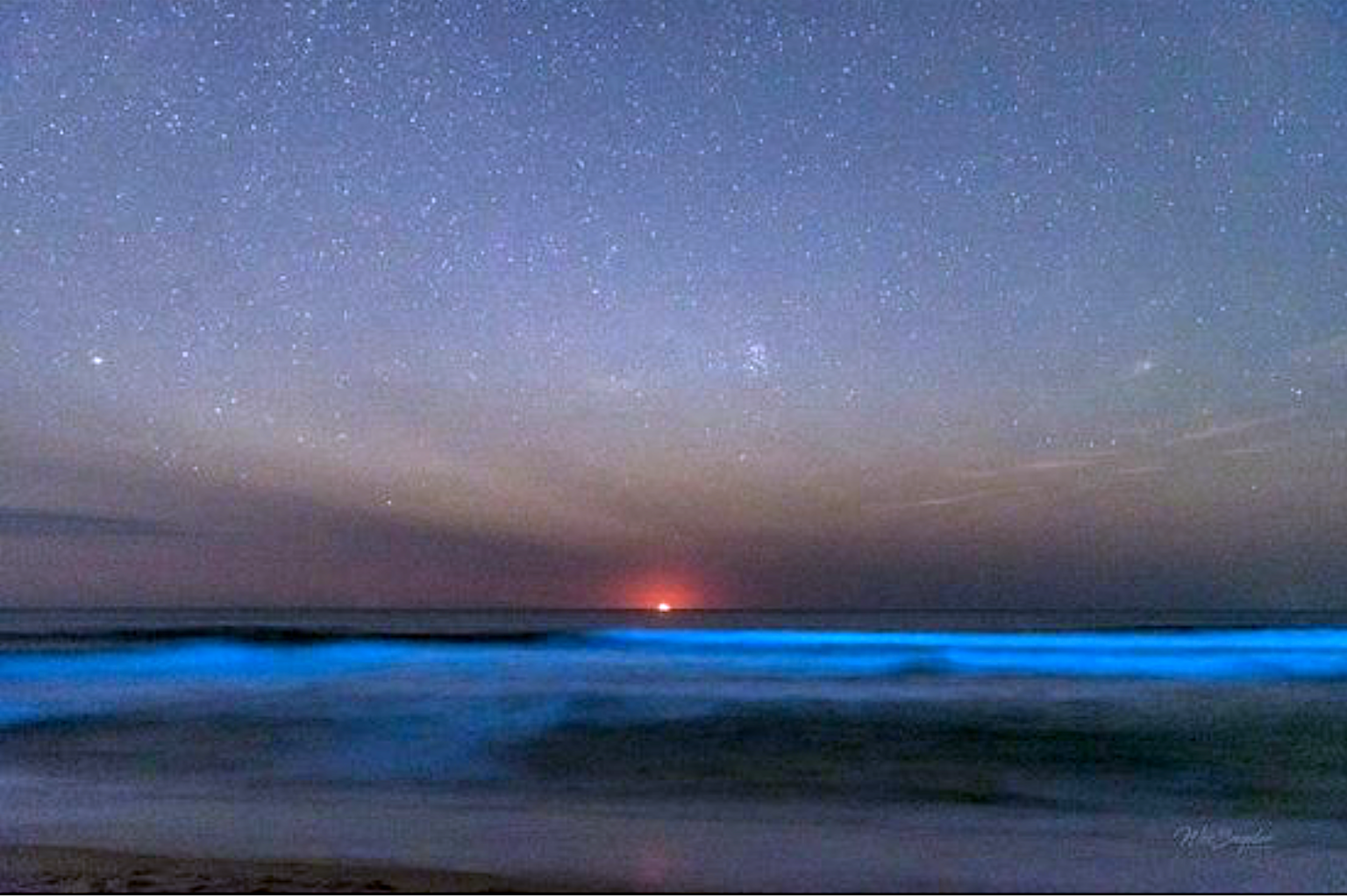
Bioluminescence in the sea.
Photo: North Carolina Sea Grant
There are many creatures that produce bioluminescence. The famous fireflies are one, but most live in the sea. The “phosphorus” we are used to seeing is produced by small single celled plants in a group known as dinoflagellates. When disturbed they emit blue-green light as a flash and then a slow dim. Fish swimming past, waves crashing on the beach, or boat and propeller pushing through the water will disturb them. The warmer the sea, the more dinoflagellates there are, the more amazing the light show is. There are lagoons in the tropical parts of the world where these small plants are trapped due to a small opening in and out of the lagoon. The entire lagoon can light up when the conditions are right.
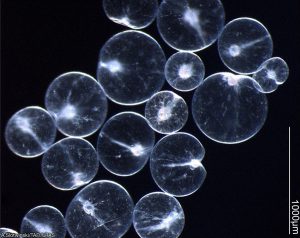
Noctiluca are one of the dinoflagellates that produce bioluminescence.
Photo: University of New Hampshire.
But it does not stop with dinoflagellates. As you descend into the deep ocean the bioluminescence becomes even more spectacular. All sorts of creatures from jellyfish to squid, to fish, to even fungus and bacteria illuminate. Some species of luminescent marine animals do not produce the light themselves but rather harbor luminescent bacteria on the skin or specially designed skim pockets to hold them. Though blue-green is the dominant color, yellows, oranges, and reds have been produced. It has been suggested that blue-green is much easier to see in the deep so reds and oranges are less likely. That said, it is believed that some marine creatures will produce those colors to assist in capturing prey. They can see the red light, but their prey cannot.
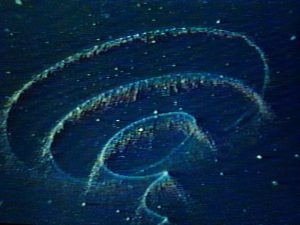
The magical lights of the deep sea.
Photo: NOAA
Either way the illumination of the ocean, like the Christmas illumination of our streets and homes, is beautiful and amazing thing. As you admire the lights on the neighborhood home, find some short videos of bioluminescence online and enjoy the show. Happy Holidays everyone.




















